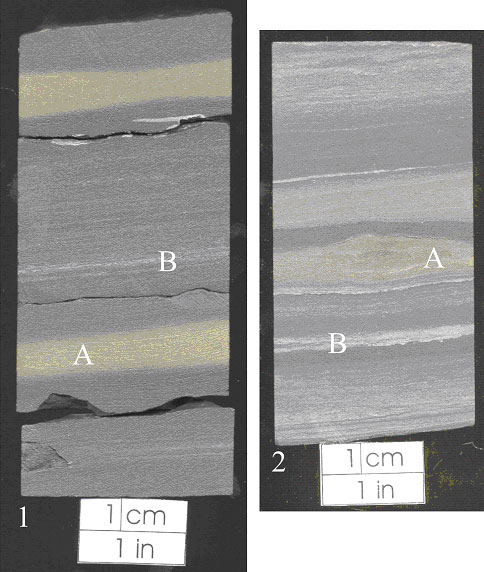 |
|
Kansas Geological Survey Open-file Report 2003-82 |
2.1.5 Sideritic Shale Facies
Description
Diagnostic features of the sideritic shale facies include quartz silt, parallel
fissile laminae (less than 3 mm), dark gray to black color, and abundant clay
ironstone bands (cf. siderite) that are approximately 1 inch in height (2.5
cm; Figure 2.07). Carbonaceous plant material are found throughout the facies.
Body fossils were not observed, but actively filled horizontal burrows (cf.
Planolities) are present. Overall, the intensity of bioturbation is relatively
low. Thickness of the sideritic shale facies ranges from 6 to 12 feet (1.8
to 3.6 m). Contacts with overlying and underlying facies are gradational.
Paleoenvironmental Interpretation
Consistency of parallel laminated shale indicates sediment fallout in a low
energy environment possibly due to upwelling or pseudo-estuarine circulation
(Heckel, 1977). Fissility, plant material, and the dark gray to black appearance
suggest a relatively high organic content. The low trace fossil diversity
may indicate a stressed brackish-water, hypersaline, or anoxic environment
(Buatois et al., 1999; Reineck and Singh, 1980). Presence of abundant siderite
bands supports the presence of a marginal marine environment receiving fresh
water input (Postma, 1982). This facies is interpreted as having been deposited
in a marginal marine environment. Historically, the sideritic shale facies
would be interpreted as part of the “outside shale” in the cyclothem
model (Heckel, 1977).
 |
| Figure 2.07 - Polished core section showing the sideritic shale facies. Note the abundance of siderite bands (A), minor amount of quartz silt (B), and absence of trace of body fossils. Sample 1 from 417' in the Cooper CW#1 well, 11-T35S-R18E, Labette County, Kansas. Sample 2 from 893' in the Hinthorn CW#1 well, 14-T32S-R16E, Montgomery County, Kansas |
e-mail : webadmin@kgs.ku.edu
Last updated December 2003
http://www.kgs.ku.edu/PRS/publication/2003/ofr2003-82/chapter2_5.html